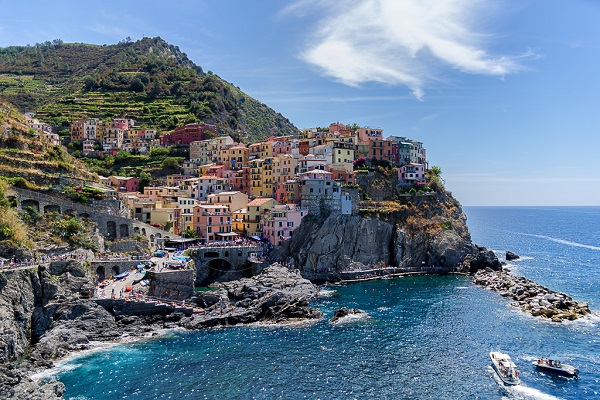CSS Masking
With CSS masking you create a mask layer to place over an element to partially or fully hide portions of the element.
The CSS mask-image Property
The CSS mask-image property specifies a mask
layer
image.
The mask layer image can be a PNG image, an SVG image, a CSS gradient, or an SVG <mask> element.
Browser Support
The numbers in the table below specify the first browser version that fully supports the property.
Numbers followed by -webkit- specify the first version that worked with a prefix.
| Property | |||||
|---|---|---|---|---|---|
| mask-image | 120 | 120 | 53 | 15.4 | 15 -webkit- |
Use an Image as the Mask Layer
To use a PNG or an SVG image as the mask layer, use a url() value to pass in the mask layer image.
The mask image needs to have a transparent or semi-transparent area. Black indicates fully transparent.
Here is the mask image (a PNG image) we will use:

Here is an image from Cinque Terre, in Italy:

Now, we apply the mask image (the PNG image above) as the mask layer for the image from Cinque Terre, Italy:

Example
Here is the source code:
.mask1 {
-webkit-mask-image: url(w3logo.png);
mask-image:
url(w3logo.png);
mask-repeat: no-repeat;
}
Try it Yourself »
Example Explained
The mask-image property specifies the image
to be used as a mask layer for an element.
The mask-repeat property specifies if or how
a mask image will be repeated. The no-repeat
value indicates that the mask image will not be repeated (the mask image will
only be shown once).
Another Example
If we omit the mask-repeat property, the mask image will be repeated all over the
image from Cinque Terre, Italy:

Example
Here is the source code:
.mask1 {
-webkit-mask-image: url(w3logo.png);
mask-image:
url(w3logo.png);
}
Try it Yourself »
Use Gradients as the Mask Layer
CSS linear and radial gradients can also be used as mask images.
Linear Gradient Examples
Here, we use a linear-gradient as the mask layer for our image. This linear gradient goes from top (black) to bottom (transparent):

Example
Use a linear gradient as a mask layer:
.mask1 {
-webkit-mask-image: linear-gradient(black, transparent);
mask-image: linear-gradient(black,
transparent);
}
Try it Yourself »
Here, we use a linear-gradient along with text masking as the mask layer for our image:
The Cinque Terre is a coastal area within Liguria, in the northwest of Italy. It lies in the west of La Spezia Province, and comprises five villages: Monterosso al Mare, Vernazza, Corniglia, Manarola, and Riomaggiore.
The Cinque Terre is a coastal area within Liguria, in the northwest of Italy. It lies in the west of La Spezia Province, and comprises five villages: Monterosso al Mare, Vernazza, Corniglia, Manarola, and Riomaggiore.
The Cinque Terre is a coastal area within Liguria, in the northwest of Italy. It lies in the west of La Spezia Province, and comprises five villages: Monterosso al Mare, Vernazza, Corniglia, Manarola, and Riomaggiore.
Example
Use a linear gradient along with text masking as a mask layer:
.mask1 {
max-width: 600px;
height: 350px;
overflow-y: scroll;
background: url(img_5terre.jpg) no-repeat;
-webkit-mask-image: linear-gradient(black, transparent);
mask-image: linear-gradient (black, transparent);
}
Try it Yourself »
Radial Gradient Examples
Here, we use a radial-gradient (shaped as a circle) as the mask layer for our image:

Example
Use a radial gradient as a mask layer (a circle):
.mask2 {
-webkit-mask-image:
radial-gradient(circle, black 50%, rgba(0, 0, 0, 0.5) 50%);
mask-image: radial-gradient(circle, black 50%, rgba(0, 0, 0, 0.5) 50%);
}
Try it Yourself »
Here, we use a radial-gradient (shaped as an ellipse) as the mask layer for our image:

Example
Use another radial gradient as a mask layer (an ellipse):
.mask3 {
-webkit-mask-image: radial-gradient(ellipse, black 50%, rgba(0,
0, 0, 0.5) 50%);
mask-image: radial-gradient(ellipse, black 50%, rgba(0, 0,
0, 0.5) 50%);
}
Try it Yourself »
Use SVG as the Mask Layer
The SVG <mask> element can be used inside an
SVG graphic to create masking effects.
Here, we use the SVG <mask> element to create different mask layers for
our image:
Example
An SVG mask layer (formed as a triangle):
<svg width="600" height="400">
<mask id="svgmask1">
<polygon fill="#ffffff" points="200 0, 400 400, 0 400"></polygon>
</mask>
<image xmlns:xlink="http://www.w3.org/1999/xlink"
xlink:href="img_5terre.jpg" mask="url(#svgmask1)"></image>
</svg>
Try it Yourself »
Example
An SVG mask layer (formed as a star):
<svg width="600" height="400">
<mask id="svgmask2">
<polygon fill="#ffffff" points="100,10 40,198 190,78 10,78
160,198"></polygon>
</mask>
<image xmlns:xlink="http://www.w3.org/1999/xlink"
xlink:href="img_5terre.jpg" mask="url(#svgmask2)"></image>
</svg>
Try it Yourself »
Example
An SVG mask layer (formed as circles):
<svg width="600" height="400">
<mask
id="svgmask3">
<circle fill="#ffffff" cx="75" cy="75"
r="75"></circle>
<circle fill="#ffffff" cx="80"
cy="260" r="75"></circle>
<circle fill="#ffffff"
cx="270" cy="160" r="75"></circle>
</mask>
<image
xmlns:xlink="http://www.w3.org/1999/xlink" xlink:href="img_5terre.jpg"
mask="url(#svgmask3)"></image>
</svg>
Try it Yourself »
CSS Masking Properties
The following table lists all the CSS masking properties:
| Property | Description |
|---|---|
| mask-clip | Specifies which area is affected by a mask image |
| mask-composite | Specifies a compositing operation used on the current mask layer with the mask layers below it |
| mask-image | Specifies an image to be used as a mask layer for an element |
| mask-mode | Specifies whether the mask layer image is treated as a luminance mask or as an alpha mask |
| mask-origin | Specifies the origin position (the mask position area) of a mask layer image |
| mask-position | Sets the starting position of a mask layer image (relative to the mask position area) |
| mask-repeat | Specifies how the mask layer image is repeated |
| mask-size | Specifies the size of a mask layer image |

